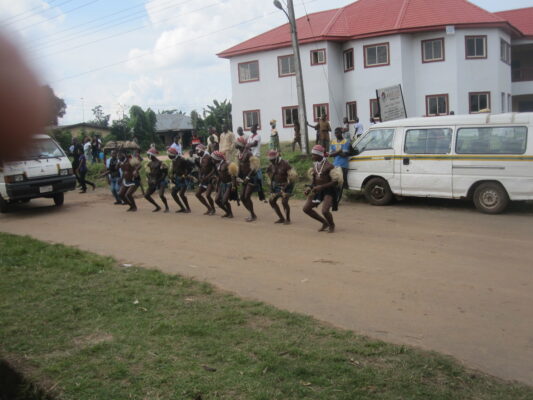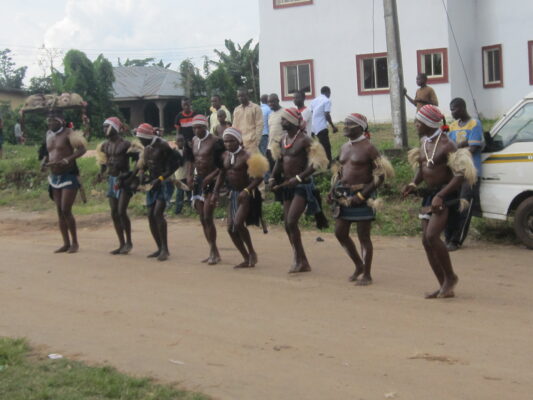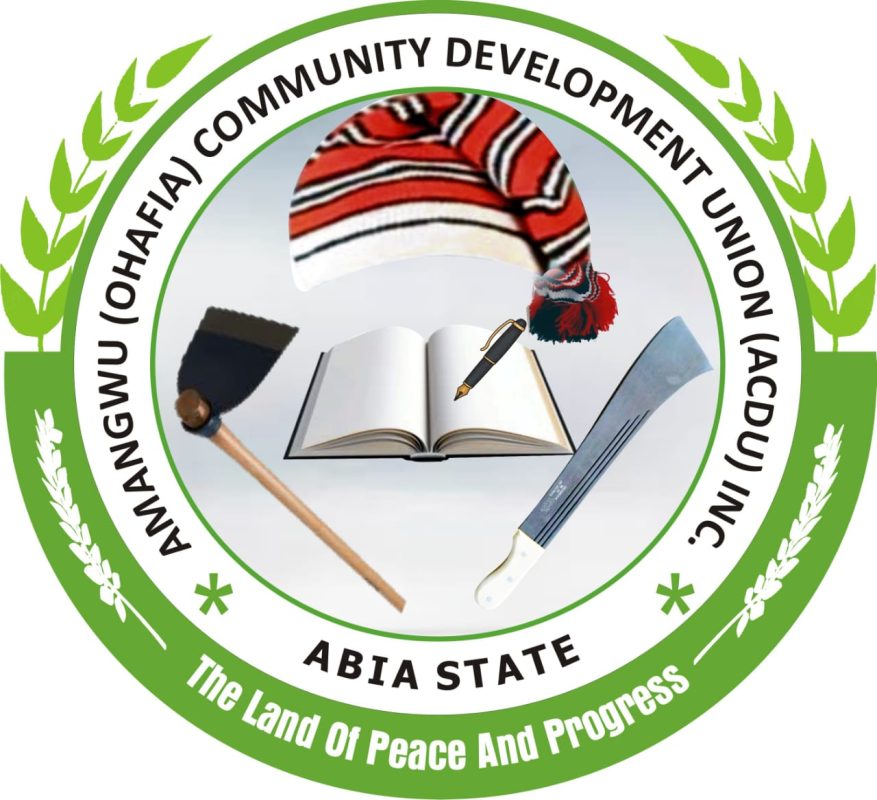OHAFIA VILLAGE SETTING: A GEOGRAPHY OF MASCULINITY

The military legacies of Ohafia society were evident in the landscape itself; in the architectural layout of Ohafia villages, and the location and gendered uses of certain cultural artifacts such as the obu, ikoro, onu-agba, and shrines such as fijoku and kamalu. These material cultures were inscribed in the physical landscape of Ohafia society, and defined a geography of masculinity. These artifacts played a significant role in the construction of ndi ikike hegemony and it is argued that the Ohafia geography of masculinity was historically constructed and reinvented in the daily practices of the people for the purpose of defense.
From the air each village would be seen to consist of very low huts, strung out in unbroken rows as if from an instinctive urge of self-defense against a danger that was once real and constant to the inhabitants . . . a protective response to a turbulent frontier environment . At the heart and center of every [village] stands the central meeting-place, ogo [village-square]. From the ogo the tertiary divisions [patrilineage compounds] radiate outwards like the spokes of a wheel and terminate towards the surrounding bush. Standing on the periphery of the ogo, the central meeting-place, and at the head of each [patrilineage compound], are the big ‘rest-huts,’ called the obu [patrilineage meeting-houses]. There is at one corner of the [obu] a small hut in which the big war-drum [ikoro] is housed . . . Also located at one corner of the ogo [village-square] is the all-important village shrine .
The [patrilineage compound] resembles the sector of a circle, and consists of unbroken rows of huts which run radially from the ogo towards the bush behind. In between each paired rows of huts [residential houses] lies a path that leads straight into the [village square], emptying directly behind the appropriate [patrilineage obu]. The hind end of the path passes through the bush surrounding the primary unit. The bush separates one territorial unit from the next.
Access to a [patrilineage compound] is possible either from the ogo or from the bush end of the unit. This means that once one finds oneself in the path one becomes effectively trapped, retreat being possible only by continuing in the direction of the ogo [village-square] or by returning towards the bush. It can therefore be imagined that should the need to defend a village arise, all that would need to be done would be to block the two ends of the path as one would a bridge.
Doors open into the paths between the paired rows of huts. A first visitor to an Ohafia [compound] is bound to experience the disquieting feeling of being watched by scores of eyes from behind the interiors of huts on either side of him, unable to see them himself. Most [compounds] are structured this way, with the

“Kpaan-kpaan-kpa-kpaan-kpaan-kpa-kpaan-kpaan-kpa … “the sound of the akwatankwa cuts through the din of the crowd gathered. The hot midday air is heavy with red dust raised by hundreds of feet: dust mixed with the rich aroma of sweat and the fragrant vapor rising from large pots of palm wine. Several young, robust men in short, coarsely woven blue loin cloths begin to move into the center of the large clearing in front of the village meeting house. Their muscular arms are draped with the long white hair of ram’s manes, and on their heads are red, black and white knit caps known as leopard hats, each pierced with an eagle feather. They move with confidence and pride but their leader seems even more imposing; balanced on his head is a board upon which human heads sculpted of wood are displayed. The heads also are flanked with ram’s mane and capped with leopard hats.
The ogo is crowded with people of all ages, some talking, greeting, laughing, others maneuvering to find a good place from which to view the dancers. The dance leader, holding a small palm shoot in his mouth and a short cutlass in his right hand, stares fixedly ahead as he dances with short deliberate steps. Three akwatankwa players sit on a wooden bench defining one edge of the dance space. With casual concentration they tap out the heart beat of the dance. Beside them a drummer begins to play, not a dance rhythm, but drum language which is echoed by the antelope horn played by one of the dancers.
Everyone should come forth!
Those in the bush come out!
Those on the road come out!
The day is charged!
An old man, dressed in a faded wrapper of Indian madras, sits on a nearby stool and begins to shout: “Utugokoko kwe’n!” and a response resounds from the crowd: “huh!” He shouts again “Akanu kwe’n! … Ohafia kwe’n! … Igbo kwe’n! … Nigeria kwe’n! …” and each time the crowd responds with urgent approval. Then he begins to sing the legend of Elibe Aja, the story of a brave hunter who establishes an alliance with the neighboring Aro people by killing a leopardess that is terrorizing their farms. The music is fast, driving, insistent. The dancers are joined by other men, some mature, some mere boys. Each moves his feet in a rapid side-stepping pattern. They roll their shoulders in tight circles causing their chest muscles to flex rapidly. Gradually, deliberately, the tempo builds. As the pace of the music increases the pectoral flexing accelerates. The men’s chests pulsate with rippling undulations. This is ofufu. As one man puts it: “when the music takes fire to the dance, the flesh melts.” Ofufu is only performed in one context: iri agha, the Ohafia “war dance.”
The musical instrument called akwatankwa is indigenous to Ohafia. It is a homely device: two slats of bamboo are struck together. Ensembles of three play, in unison, the aggressive time-line of the war dance. This single repeated phrase constitutes the core of a complex performance which embodies the ancestral foundations of Ohafia manhood. A legacy of aggressiveness, courage, and achievement are infused in the sound and movements of the war dance.
As the akwatankwa play the drum calls men to action: “Agwo ntu no akarika!” “There is a dangerous snake in the grass!” This is a warning, a call to arms, a summons to dance, to be courageous and to come prepared for action. The drum and the horn were battlefield instruments used to communicate during raids. Many of the calls these instruments produce are traditional alarms and commands and they bring the tension and immediacy of actual battle to the mood of the dance. The drum also plays the dance rhythm, fitting its tones tightly within the fast paced time-line. The drummer sings a high pitched note interjected sporadically throughout the performance which further increases the fervent tone of the event. The ensemble is small, the sound “hot,” and aggressive.
In Ohafia, the war dance is part of a distinctly masculine genre of music which is contrasted to the lilting meter of women’s music. Never pausing, the war dance pushes ahead, creating a sense of moving forward aggressively. This is embodied in the ridged bodily comportment and continuous swift movements of the war dancers. Men speak of the compelling quality of the war dance rhythm: that they cannot resist the call to dance, that the music pushes the dancers driving them to dance and to move like the warriors of old once moved. Like a voice of the ancestors themselves, the war dance induces men to do what they must do to be Ohafia men.
The sound of the war dance produces a direct link between the ancestral values that the music invokes and the bodily experience that it evokes. The undulating chest movement called ofufu constitutes a somatic rather than a semantic association: an immediately experienced bodily cognizance rather than an abstracted codified message. When the sound of akwatankwa travels through the village many young men and boys respond physically to the call, executing the dance and performing ofufu. The word ofufu is unique to dialects in the Ohafia region. It is probably derived from the verb root “fu”: to blow, or to receive an electric shock. The common characteristic shared by electric shock, blowing, and ofufu is the sense of a force moving through the body. In the case of ofufu, this force is the ancestral power of Ohafia warriors. It is said that the akwatankwa “push” this force, filling Ohafia men with the power of their heroic ancestors which manifests as ofufu. Hence, when the sound of akwatankwa is heard, the insistent rhythm carries with it a sense of what it means to be an Ohafia man, a descendent of courageous warriors.
The war dance is a dramatic embodiment of Ohafia masculinity and the power associated with their ancestral heritage. The Ohafia word for chest is used idiomatically in a manner similar to the way “heart” is in English. Thus, it is said of a happy person “his chest is sweet.” Of the courageous it is said that their chest is powerful. Ofufu manifests the sense of a powerful chest as a dramatically embodied and experienced fact. The dancers are dressed with concentrated clusters of signification: images evocative of ruthlessness, courage and masculinity. The ram’s mane, the eagle feathers, the mimesis of the color and movement of the leopard establish an immediate affinity between the war dancers and the virility and power of these animals.
The lead dancer carries a headdress bearing heads. In the past, when a warrior was celebrated after returning from battle with a human head as a trophy, the headdress was a large pot, blackened with sacrificial blood, upon which were tied the prepared skulls of particularly formidable victims of the past. At other times, a long board covered with leopard skin and bearing carved wooden representations of heads was carried to honor men who had killed leopards or had performed other brave deeds which were considered to be acts equivalent to the taking of a human head in battle.
The skull studded pots are still maintained but they have largely become relics of an earlier age. The leopard board however, is at the center of a living tradition. Now used to celebrate men who have succeeded in business and educational endeavors, it resonates as a key symbol of the relationship between traditional Ohafia culture and the endeavors faced by Ohafia men in the modern world.
The ceremony occurs in commemoration of a particular person’s accomplishments and the dance is performed in the village section in which the celebrant’s paternal descent group resides. While people will often say that the war dance “belongs to the whole of Ohafia,” particular performances “belong” to individual men. By performing the war dance the community gives recognition to men of achievement. But in doing so, these men become empowered to define what constitutes achievement in their own generation.
The war dance has changed considerably in the past century. The battles of the past have been relegated to remote history. But the dance remains at the heart of Ohafia identity. While the age of head-taking is gone, modern markers of achievement serve equally well as tokens of proven courage and affirmed manhood. New signs have become structurally equivalent to “heads,” worthy of celebration just as, in the past, the hunter who killed a leopard was celebrated as having “taken a head.” This idiomatic transference is frequently explained in blunt terms by Ohafia people who remark: “we used to go to war and bring back heads, now we go and bring back degrees.”
The war dance is about achievement of manhood by way of incorporation of the Other and appropriation of power. The head continues to stand as a resonant symbol of this achievement, but the actions which constitute the appropriation of power have transformed to embrace the structures and relations of modernity: the corporation, the academy, and the state. Hence, when a man returns to Ohafia with an academic degree or arrives in his home village in a Mercedes-Benz he is said to have “taken a head.”
The identity realized here is not in the appropriated objects themselves or even in the power that they represent, but in the all important action of returning with them. Those who stay in the city and lose contact with their natal villages are referred to as “lost,” as were the warriors who failed to return from battle. Material rewards are not enough to constitute an authentic identity. The sojourn must be completed. The warrior must return, be celebrated, meet his ancestors, and join in the community of heros. Through adaptation of the warrior tradition, the war dance provides a continuity with the past which circumvents the upheavals and social changes which have characterized the last century by appropriating these new elements. It is an embodiment of Ohafia identity which, faced with the transforming influences of consumer culture, religious conversion, and literacy, refuses to succumb and instead incorporates these elements like so many skulls adorning the shrine of an unconquerable people.
The war dance is located at the nexus of history and tradition in Ohafia: that point in social process where the contingent and reflexive acts of individual “history makers” are made coherent and meaningful in relation to an ancestral tradition. The acts themselves are not bound to any particular form. Like comparable events in all societies, the war dance positions participants in relation to the cycles of tradition and the contingent unfolding of history.
Processes of “time binding” are explicitly constructed in the war dance. Each performance is initiated by an offering of libations to the ancestors. They are called to come, to share the drink and to join with the living in celebration of Ohafia’s heroes, past and present. This action clears the way for the subsequent events and delineates a space in which the boundaries between the living and the dead: the past and the present, become permeable.
This manipulation of time consciousness is fundamental to the experiential dimensions of the war dance. Through aesthetically framed enactments of past events and ancestral heroes, the war dance constitutes a collective experience which extends through time, linking the living to their predecessors. The term “history” fails to convey this sense of community unfolding through time. It is an experience of transtemporal communitas which is at the core of each individual’s identification with the war dance event and ultimately with what it means to be Ohafia. The collective community which participates in the creation of the war dance includes the living and the dead; for without the ancestors there would be no community with which to identify.
This presence of ancestors is not a “supernatural” notion. Rather, it is an empirically experienced glimpse of a social reality extending through time over many generations and thus normally outside of the mundane experience of present time consciousness. This notion is eloquently expressed by Ogba Kalu of Abia, Ohafia who stated:
Whenever [the war dance] is performed, our hearts brim with joy: because it is the umbilical cord with which we were born. Whenever we hear its rhythm, our-hearts swell with joy: we think of the day of our birth and cherish the day of our death; we think of the day we shall raise our heads in pride and rejoice in anticipation of the day we shall grow rich … So then, we are most happy to see it performed every time. (Azuonye 1974:96)
By dancing as the ancestors danced Ohafia people also dance with them. The war dance engages the performer with the past in a manner which collapses the temporal ontology that divides the living and the dead. In this way, participants experience individual existence as a part of a greater whole. When Ohafia men dance the war dance, they position themselves in social time and space with their ancestors as ancestors in the making. They come to know that to prevail in their own lives they must live like those brave warriors who brought them into the world. This is not a denial of the present moment but a recognition that the past subsumes it. In this warrior’s dance the past is the final conqueror, ultimately incorporating all people and events into its fold.
The Ohafia War Dance does more than express Ohafia notions of power, ethnicity, gender and history. It structures a lived experience of these and in doing so it becomes the very means of producing them. It is this creative aspect of social power which, in Ohafia, is bestowed by ancestors and may be physically experienced in dance. The Ohafia notion of power (ike), so vividly manifest in the war dance. The Ohafia warrior tradition is a social production as well as a social fact. Although people are driven to achieve greatness because they are born into a tradition which demands it, all individuals fight their own battles, bearing responsibility for their achievements and failures. In Ohafia as elsewhere, the performance arts embody this constitutive process. They create a nexus at which the individual and the collective intersect. It is at this nexus of the part and the whole, the person and society, identity and history, creator and created, that social forms emerge and can be transformed. Such a view accounts for that fact that the war dance has retained currency in Ohafia in spite of the fact that head taking, its putative object, is no longer practiced. The dance itself has proven to be more vital than the practice it originally commemorated, the act of celebration more definitive than the act celebrated.
